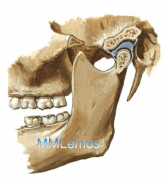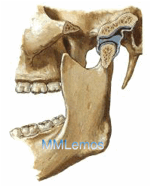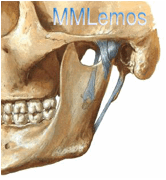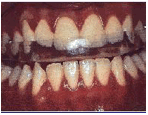TMJ disorder
Temporomandibular disorders (TMD) are disorders of multiple etiology affecting the facial muscles and temporomandibular joint (TMJ) and are characterized by pain in the preauricular, limited jaw movements, noises in the joint, muscle tenderness to palpation and joint inflammation.
The splint (PI) or occlusal splints may be indicated for cases of TMD. The conservative, reversible and non-invasive is one of the basic principles in the management of TMD.
The devices are useful for screening interoclusias certain etiological factors. When a malocclusion is suspected to be the cause of a DTM, the occlusal appliance therapy can rapidly and in a reversible manner to introduce a more desirable occlusal condition, so if there is no remission of symptoms of TMD probability of malocclusion be an etiological factor is small.
 There are two types of plates covering the entire arches, the reposicionadoras and muscle relaxants. The microrelaxants allow muscles to work according to their coordinated interactions, thus eliminating the cause and effect of muscular incoordination, for this reason are often also called deprogrammers muscle. There are two types of plates covering the entire arches, the reposicionadoras and muscle relaxants. The microrelaxants allow muscles to work according to their coordinated interactions, thus eliminating the cause and effect of muscular incoordination, for this reason are often also called deprogrammers muscle.
The plates reposicionadoras in the buccal cavity when adapted to maintain the jaw in a more anterior than the maximum intercuspidation position of the patient, enhancing in some cases the recovery of the articular disk and restoring normal function.
The great difficulty in evaluating the effectiveness of therapeutic literature of occlusal splints, lies in the fact of not having a standardization of research in relation to the instruments used, the index used to evaluate the success or failure and the time of the use of PLs among others.

The emotional factor of the patient may have important implications in treatment success.
Headaches: muscle pain localized in the area of masseter and anterior temporal factor is always identified as the beginner headaches located in the frontal, temporal and parietal lobes. It is interesting to note when 70% of patients with TMD have recurrent headaches. It should be noted that occlusal factors may be related as possible etiologic agents of pains in the head and neck.
|

|
TMJ pain: TMJ pain originates in the periarticular tissues containing nociceptors when these ligaments are stretched or compressed, nociceptors send signals that are picked up as joint pain. And if these articular structures collapse, inflammation can produce a constant pain that is exacerbated by jaw movements.
One of the most common symptoms of TMD is pain in the region that is present pre headset when there is any movement of the jaw or even at home. There are numerous factors that can lead to painful symptoms of TMJ, but the most common are due to repetitive trauma and adverse TMJ (parafunctional) with consequent inflammation and degeneration of joint structures. A commonly used alternative therapy for joint pain is a prescription anti-inflammatories, but the evaluation of the real effect of drug therapy versus therapy by PIs should be clarified.
Muscle pain: nerve endings in the muscles are highly sensitive to the increased lactic acid and ischemia, and when sensitized by these mechanisms, the nerve endings interpreted as pain stimuli. The occlusal condition can increase muscle hyperactivity daytime to a greater degree than the nocturnal activity and thus unfavorable occlusal conditions can maximize the activity and muscle tone which in turn leads to collapse. It is noteworthy that the PIs are highly effective for patients suffering from pain of masticatory muscles.
 The literature seems clear on the beneficial effects of PI relaxation in the treatment of joint pain, muscle and headaches. Once the diagnosis of TMD requires care and knowledge of possible factors that are causing dysfunction in stomatognatic plates serve primarily as diagnostic and at the same time relieving acute pains that often accompany the TMDs. The literature seems clear on the beneficial effects of PI relaxation in the treatment of joint pain, muscle and headaches. Once the diagnosis of TMD requires care and knowledge of possible factors that are causing dysfunction in stomatognatic plates serve primarily as diagnostic and at the same time relieving acute pains that often accompany the TMDs.
 The PI therapy is a form of conservative treatment and very valuable in remission of signs and symptoms of TMD, and along with other therapies such as moist heat, muscle stretching exercises, relaxation the psychological orientation of a soft diet, maintaining correct posture habits among others, promoting a success in most cases. The PI therapy is a form of conservative treatment and very valuable in remission of signs and symptoms of TMD, and along with other therapies such as moist heat, muscle stretching exercises, relaxation the psychological orientation of a soft diet, maintaining correct posture habits among others, promoting a success in most cases.
Source: Journal of Dentistry Paulista Year XXV - No. 5 - September - 2003
|

 There are two types of plates covering the entire arches, the reposicionadoras and muscle relaxants. The microrelaxants allow muscles to work according to their coordinated interactions, thus eliminating the cause and effect of muscular incoordination, for this reason are often also called deprogrammers muscle.
There are two types of plates covering the entire arches, the reposicionadoras and muscle relaxants. The microrelaxants allow muscles to work according to their coordinated interactions, thus eliminating the cause and effect of muscular incoordination, for this reason are often also called deprogrammers muscle.

 The literature seems clear on the beneficial effects of PI relaxation in the treatment of joint pain, muscle and headaches. Once the diagnosis of TMD requires care and knowledge of possible factors that are causing dysfunction in stomatognatic plates serve primarily as diagnostic and at the same time relieving acute pains that often accompany the TMDs.
The literature seems clear on the beneficial effects of PI relaxation in the treatment of joint pain, muscle and headaches. Once the diagnosis of TMD requires care and knowledge of possible factors that are causing dysfunction in stomatognatic plates serve primarily as diagnostic and at the same time relieving acute pains that often accompany the TMDs. The PI therapy is a form of conservative treatment and very valuable in remission of signs and symptoms of TMD, and along with other therapies such as moist heat, muscle stretching exercises, relaxation the psychological orientation of a soft diet, maintaining correct posture habits among others, promoting a success in most cases.
The PI therapy is a form of conservative treatment and very valuable in remission of signs and symptoms of TMD, and along with other therapies such as moist heat, muscle stretching exercises, relaxation the psychological orientation of a soft diet, maintaining correct posture habits among others, promoting a success in most cases.